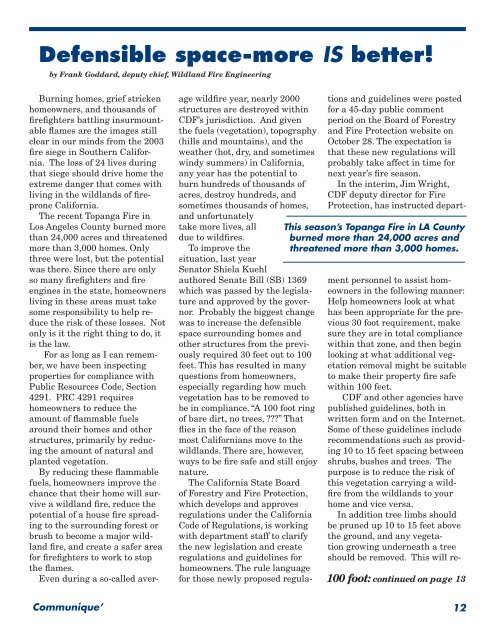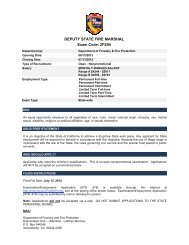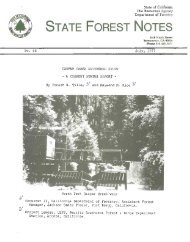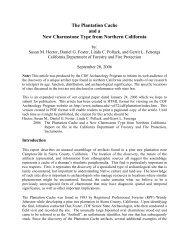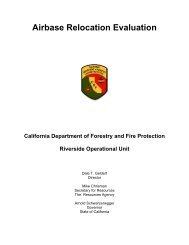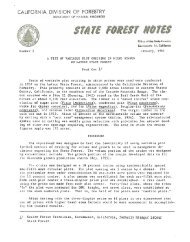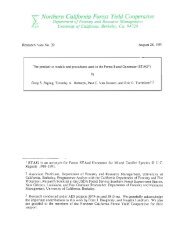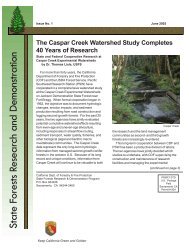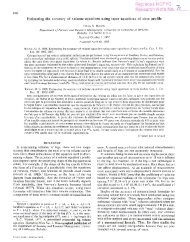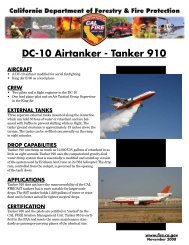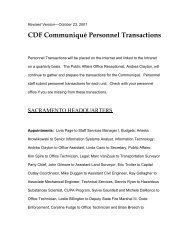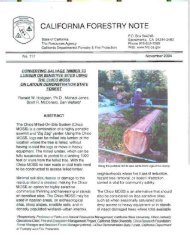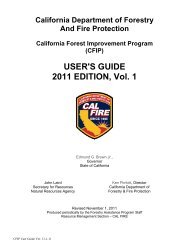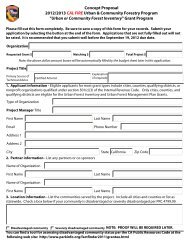Communique' - California Department of Forestry and Fire Protection
Communique' - California Department of Forestry and Fire Protection
Communique' - California Department of Forestry and Fire Protection
Create successful ePaper yourself
Turn your PDF publications into a flip-book with our unique Google optimized e-Paper software.
Defensible space-more IS better!<br />
by Frank Goddard, deputy chief, Wildl<strong>and</strong> <strong>Fire</strong> Engineering<br />
Burning homes, grief stricken<br />
homeowners, <strong>and</strong> thous<strong>and</strong>s <strong>of</strong><br />
fi refi ghters battling insurmountable<br />
fl ames are the images still<br />
clear in our minds from the 2003<br />
fi re siege in Southern <strong>California</strong>.<br />
The loss <strong>of</strong> 24 lives during<br />
that siege should drive home the<br />
extreme danger that comes with<br />
living in the wildl<strong>and</strong>s <strong>of</strong> fi reprone<br />
<strong>California</strong>.<br />
The recent Topanga <strong>Fire</strong> in<br />
Los Angeles County burned more<br />
than 24,000 acres <strong>and</strong> threatened<br />
more than 3,000 homes. Only<br />
three were lost, but the potential<br />
was there. Since there are only<br />
so many fi refi ghters <strong>and</strong> fi re<br />
engines in the state, homeowners<br />
living in these areas must take<br />
some responsibility to help reduce<br />
the risk <strong>of</strong> these losses. Not<br />
only is it the right thing to do, it<br />
is the law.<br />
For as long as I can remember,<br />
we have been inspecting<br />
properties for compliance with<br />
Public Resources Code, Section<br />
4291. PRC 4291 requires<br />
homeowners to reduce the<br />
amount <strong>of</strong> fl ammable fuels<br />
around their homes <strong>and</strong> other<br />
structures, primarily by reducing<br />
the amount <strong>of</strong> natural <strong>and</strong><br />
planted vegetation.<br />
By reducing these fl ammable<br />
fuels, homeowners improve the<br />
chance that their home will survive<br />
a wildl<strong>and</strong> fi re, reduce the<br />
potential <strong>of</strong> a house fi re spreading<br />
to the surrounding forest or<br />
brush to become a major wildl<strong>and</strong><br />
fi re, <strong>and</strong> create a safer area<br />
for fi refi ghters to work to stop<br />
the fl ames.<br />
Even during a so-called aver-<br />
age wildfi re year, nearly 2000<br />
structures are destroyed within<br />
CDF’s jurisdiction. And given<br />
the fuels (vegetation), topography<br />
(hills <strong>and</strong> mountains), <strong>and</strong> the<br />
weather (hot, dry, <strong>and</strong> sometimes<br />
windy summers) in <strong>California</strong>,<br />
any year has the potential to<br />
burn hundreds <strong>of</strong> thous<strong>and</strong>s <strong>of</strong><br />
acres, destroy hundreds, <strong>and</strong><br />
sometimes thous<strong>and</strong>s <strong>of</strong> homes,<br />
<strong>and</strong> unfortunately<br />
take more lives, all<br />
due to wildfi res.<br />
To improve the<br />
situation, last year<br />
Senator Shiela Kuehl<br />
authored Senate Bill (SB) 1369<br />
which was passed by the legislature<br />
<strong>and</strong> approved by the governor.<br />
Probably the biggest change<br />
was to increase the defensible<br />
space surrounding homes <strong>and</strong><br />
other structures from the previously<br />
required 30 feet out to 100<br />
feet. This has resulted in many<br />
questions from homeowners,<br />
especially regarding how much<br />
vegetation has to be removed to<br />
be in compliance. “A 100 foot ring<br />
<strong>of</strong> bare dirt, no trees, ???” That<br />
fl ies in the face <strong>of</strong> the reason<br />
most <strong>California</strong>ns move to the<br />
wildl<strong>and</strong>s. There are, however,<br />
ways to be fi re safe <strong>and</strong> still enjoy<br />
nature.<br />
The <strong>California</strong> State Board<br />
<strong>of</strong> <strong>Forestry</strong> <strong>and</strong> <strong>Fire</strong> <strong>Protection</strong>,<br />
which develops <strong>and</strong> approves<br />
regulations under the <strong>California</strong><br />
Code <strong>of</strong> Regulations, is working<br />
with department staff to clarify<br />
the new legislation <strong>and</strong> create<br />
regulations <strong>and</strong> guidelines for<br />
homeowners. The rule language<br />
for those newly proposed regula-<br />
tions <strong>and</strong> guidelines were posted<br />
for a 45-day public comment<br />
period on the Board <strong>of</strong> <strong>Forestry</strong><br />
<strong>and</strong> <strong>Fire</strong> <strong>Protection</strong> website on<br />
October 28. The expectation is<br />
that these new regulations will<br />
probably take affect in time for<br />
next year’s fi re season.<br />
In the interim, Jim Wright,<br />
CDF deputy director for <strong>Fire</strong><br />
<strong>Protection</strong>, has instructed depart-<br />
This season’s Topanga <strong>Fire</strong> in LA County<br />
burned more than 24,000 acres <strong>and</strong><br />
threatened more than 3,000 homes.<br />
ment personnel to assist homeowners<br />
in the following manner:<br />
Help homeowners look at what<br />
has been appropriate for the previous<br />
30 foot requirement, make<br />
sure they are in total compliance<br />
within that zone, <strong>and</strong> then begin<br />
looking at what additional vegetation<br />
removal might be suitable<br />
to make their property fi re safe<br />
within 100 feet.<br />
CDF <strong>and</strong> other agencies have<br />
published guidelines, both in<br />
written form <strong>and</strong> on the Internet.<br />
Some <strong>of</strong> these guidelines include<br />
recommendations such as providing<br />
10 to 15 feet spacing between<br />
shrubs, bushes <strong>and</strong> trees. The<br />
purpose is to reduce the risk <strong>of</strong><br />
this vegetation carrying a wildfi<br />
re from the wildl<strong>and</strong>s to your<br />
home <strong>and</strong> vice versa.<br />
In addition tree limbs should<br />
be pruned up 10 to 15 feet above<br />
the ground, <strong>and</strong> any vegetation<br />
growing underneath a tree<br />
should be removed. This will re-<br />
100 foot: continued on page 13<br />
Communique’ 12


